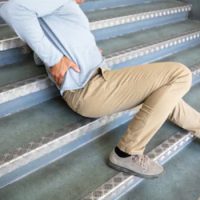Slip and Fall Physics Are More Complex Than You May Think

You probably know of, or have heard of people who fall inside of property. But it turns out, not every fall is the same, and there is actually a lot of science behind falls, how they happen, and the types of falls that can happen. And in a typical slip and fall case, often, there is more scientific evidence presented at trial than you would think.
Smaller, Unnoticeable Falls
One type of fall, isn’t actually a fall at all. That’s because it is so small, that most of our bodies compensate and adjust for it. In fact, you may not even be aware that it is happening. There are small losses of friction or traction that cause a slip of about 1-3 centimeters.
But just because the slip is small, doesn’t mean it isn’t dangerous; many people who are less limber can end up in a full blown fall, even with this small loss of friction.
Slipping, Sliding and Tripping
There is also a difference between a slip and a slide, as the words themselves imply.
In a slip, the foot loses traction for about 10 centimeters. Here, you will probably notice and “catch yourself,” or at least, you can try to do so. Again, many people who are less agile may not be able to catch themselves, and can end up on the ground and injured, in a slip accident.
Sliding is where the foot completely is riding on something (an object, or a slick surface), for an extended distance. A fall is virtually guaranteed here.
A trip is a completely different thing, and involves another object that causes or contributes to a fall. Imagine a box on the floor, or something jutting out into a walkway.
Your Gait and Instability
It also makes a difference when you encounter an object, or a slippery surface, as far as when in the process of your normal walk or gait that your body encounters the object.
Although it feels like you are constantly stable during the course of your normal walk, you actually are not. You actually only have complete stability, in about 20% of your normal gait.
That doesn’t mean you automatically fall during the other 80%, it just means that if you encounter something destabilizing, like an object or a wet surface, during that 80%, you are more likely to fall, and less able to catch yourself before you fall.
Speed and Weight Factors
The friction of your foot on and against the ground matters as well, and we often do things to lower friction. The faster you go, the harder your foot pounds into the ground, and thus, the more difficult it may be for your foot to keep traction, especially if it encounters a wet or slippery surface.
Even holding something heavy can increase our weight, increasing the load on our feet, and thus, making our feet more likely to slip out from under us when encountering an object or substance.
The slip and fall injury attorneys at Joseph Linnehan Jr. can help if you have been in a falling accident. Call the Boston personal injury lawyers at The Law Office of Joseph Linnehan, Jr. today at 617-275-4200 for questions and for help.
Sources:
carrierchronicles.com/the-science-behind-slip-trip-and-fall-prevention/
sciencetimes.com/articles/39876/20220912/the-science-behind-slip-and-fall-accidents-and-how-to-prevent-them.htm
